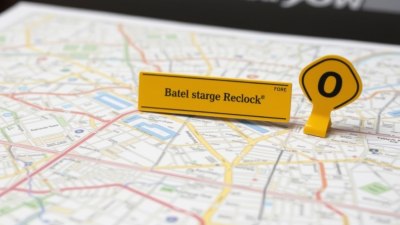There’s a Street Missing From Every Map
Discover the mystery behind the street missing from every map and its intriguing implications.

Image created with Flux Schnell
Maps are an essential tool for navigation, providing us with a way to understand the world around us. They represent everything from major highways to tiny alleyways, capturing the essence of urban life and the layout of cities. However, there is an enigmatic concept that intrigues geographers and historians alike: the phenomenon of a street missing from every map. What does this mean for the way we perceive and interact with our environments?
At first glance, the phrase 'a street missing from every map' might conjure images of ghost towns or forgotten paths. Indeed, these streets exist in many forms and can represent various ideas—whether they are physical roads that have fallen out of use, or metaphorical pathways illustrating societal issues. In this exploration, we will delve deeper into the significance of this idea, its implications on urban development, societal memory, and the ways in which we document our world.
The Ghost Streets of Urban Landscapes
One of the most literal interpretations of a street missing from every map is found in the concept of ghost streets. These are roads that once bore vibrant communities but have since been abandoned due to various factors such as urban redevelopment, economic decline, and shifting demographics. Cities around the world have seen neighborhoods razed to make way for new constructions, rendering streets that were once bustling with life into mere memories.
In some cases, corporate interests may dictate the fate of these streets. For example, a thriving neighborhood might be bulldozed to make space for a shopping mall or high-rise apartments, displacing residents and erasing histories. Consequently, the erased street symbolically represents loss—not just of physical space, but also of cultural heritage. The absence of these streets from official maps signifies how we often forget the past in pursuit of progress.
The Role of Memory in Urban Mapping
Mapping goes beyond a mere representation of geography; it is an act of remembrance. A street missing from every map highlights the limitation of official records to capture the lived experiences of people in a community. Urban planners and mapmakers make decisions that can inadvertently marginalize the stories of others. Streets that are not recognized on maps may represent the struggles and triumphs of underrepresented communities.
This raises a significant question: how should we document our cities to reflect their true essence? Many grassroots movements have emerged, advocating for community-driven mapping initiatives that prioritize local knowledge and experiences. These efforts often challenge conventional representations of urban spaces, seeking to include the stories of those who reside in neighborhoods often overlooked by formal planners.
The Impact of Technology on Mapping
In an age where technology facilitates our understanding of spaces through platforms like Google Maps and GPS, the idea of a street missing from every map takes on new dimensions. While modern technology enhances accessibility to navigation tools, it also presents challenges related to accuracy and representation. Data may be cherry-picked and not all streets receive equal attention.
Additionally, the algorithms that power these platforms may inadvertently exclude context and history, leading to a flattened understanding of urban environments. New tools have emerged that offer alternate mapping experiences, such as interactive maps and augmented reality applications, which are designed to tell the stories behind locations rather than simply display geographical boundaries. Such innovations remind us of the importance of storytelling in our understanding of physical spaces.
Ghost Streets Around the World
Different cultures have their interpretations of missing streets. In Paris, for example, some streets have been entirely eliminated as part of the urban renewal efforts, leading to a cultural shift in how residents interact with their city. The Rue de la Lune, once a lively street filled with boutiques and cafes, is now a memory for locals who lament its absence.
In other parts of the world, entire neighborhoods have been erased due to political reasons. The streets of Lviv in Ukraine tell stories of resilience and survival amid invasions and occupation, yet certain pathways may vanish from new maps due to ongoing changes. As a result, some communities work tirelessly to preserve their stories, ensuring future generations will remember those missing streets and their histories.
The Psychological Implications of Missing Streets
The presence of a street missing from every map affects not only how we navigate our environments but also how we perceive our identity within them. Streets are more than just physical locations; they embody memories, relationships, and culture. When a street is erased from a map, it can lead to a profound sense of loss for communities, contributing to feelings of dislocation and disconnect.
Urban sociologists assert that the physical absence of a street invariably influences people’s attachments to their neighborhoods. When streets that once fostered community involvement are no longer acknowledged, it can create an emotional void for those who have strong family and cultural ties to these repressed spaces. Therefore, mapping becomes a reflection of both physical geography and social reality.
Preserving the Legacy of Missing Streets
Efforts to keep the memories of these abandoned streets alive often manifest in various forms. Local historians curate exhibitions, neighborhood groups organize events, and artists create murals or public installations—each attempting to document the cultural significance embodied in those ghostly remnants. Through this creative expression, communities work towards healing their narratives, providing a means of reclamation for places that have been erased from mainstream consciousness.
The legacy of missing streets serves as an important reminder of the past. By fostering appreciation for our histories and the inherited lives connected to tangible places, we nurture the identity of both individuals and their communities. Navigating toward the future should not mean disregarding the roads we have traversed before.
Future Perspectives on Mapping
As we advance into an era of increased digital mapping, it is critical we remain aware of the narratives we may be working to unearth or obscure. Civic engagement in mapping initiatives requires ongoing advocacy for preserving cultural heritage while innovating new technologies for urban representation. The intention should be to capture the complexities of urban landscapes instead of simplifying them to suit commercial interests.
Education about the significance of place is vital. By teaching individuals about the stories embedded in their local streets—recognizing not only those that are present but also those that are missing—we contribute to a greater sense of belonging. As urban spaces continue to evolve, understanding the weight of past experiences allows us to imagine more inclusive futures.
In summary, the idea of a street missing from every map opens up discussions about loss, memory, identity, and the responsibility we carry in preserving the stories that shape our environments. Ghost streets might not exist on paper; however, they continue to echo through communities, embodying histories that must not be forgotten. As we navigate our cities today, let us remain mindful of the past while seeking to forge future pathways that honor all the narratives—both existing and erased—within our urban landscapes.











